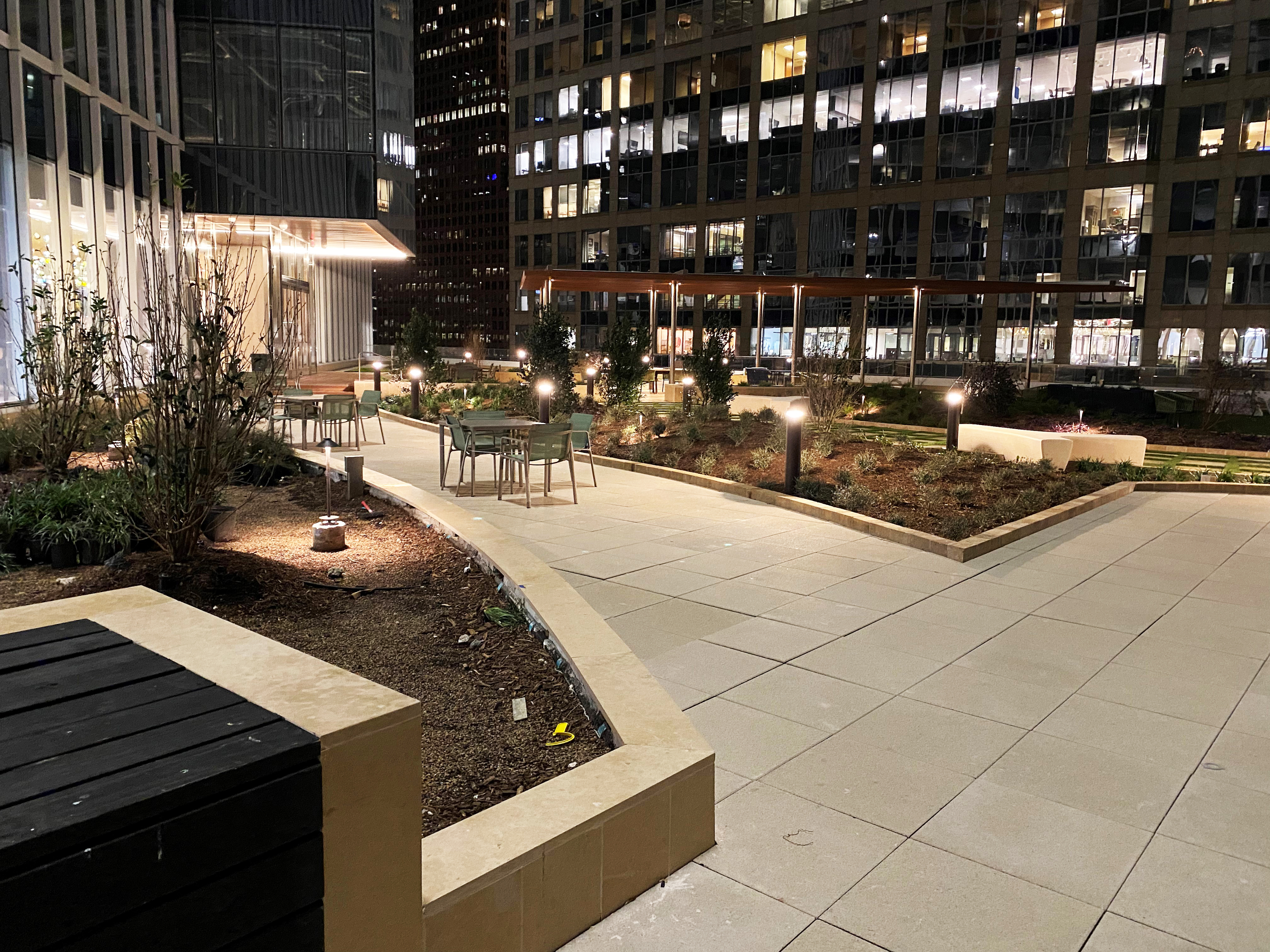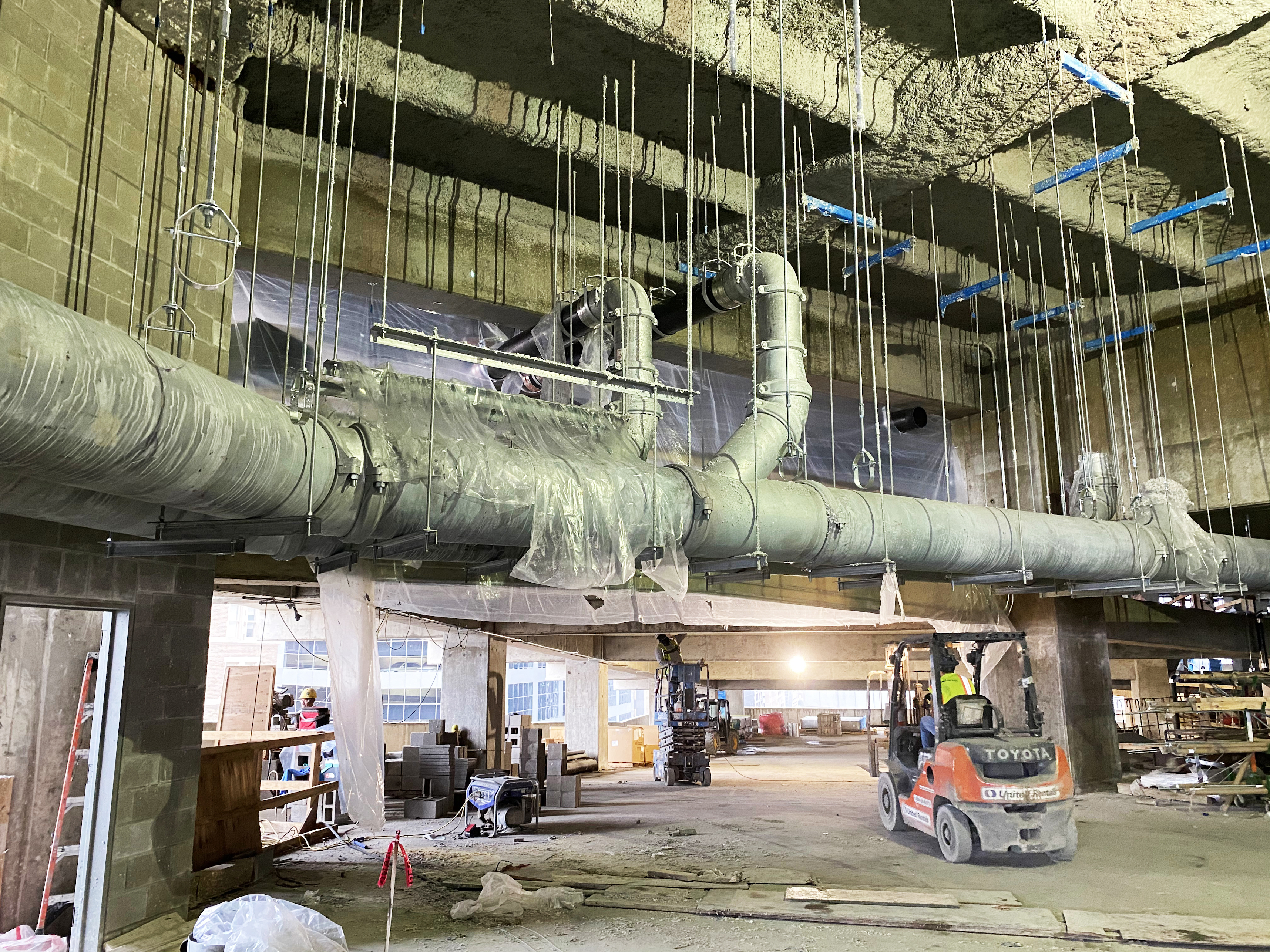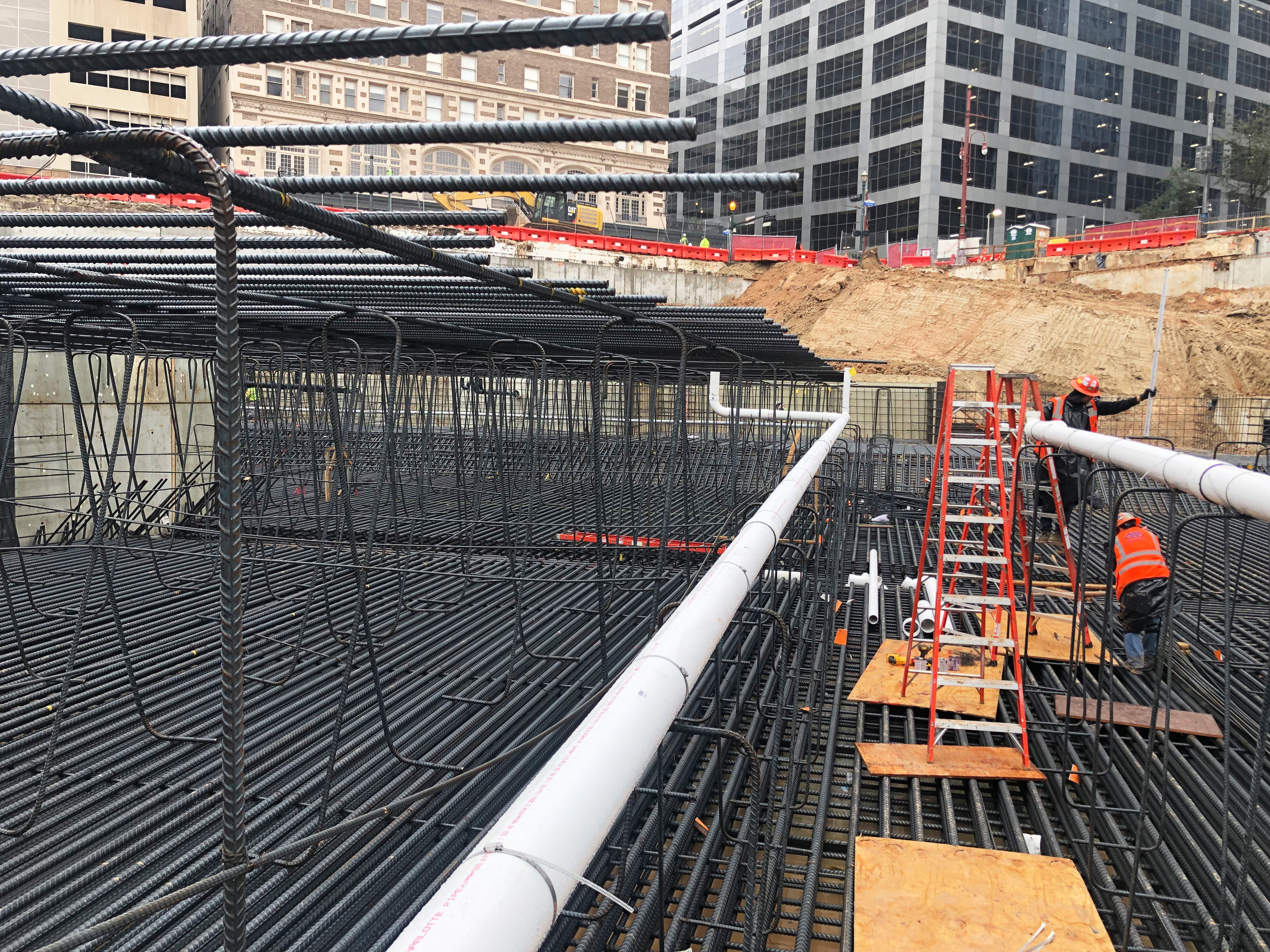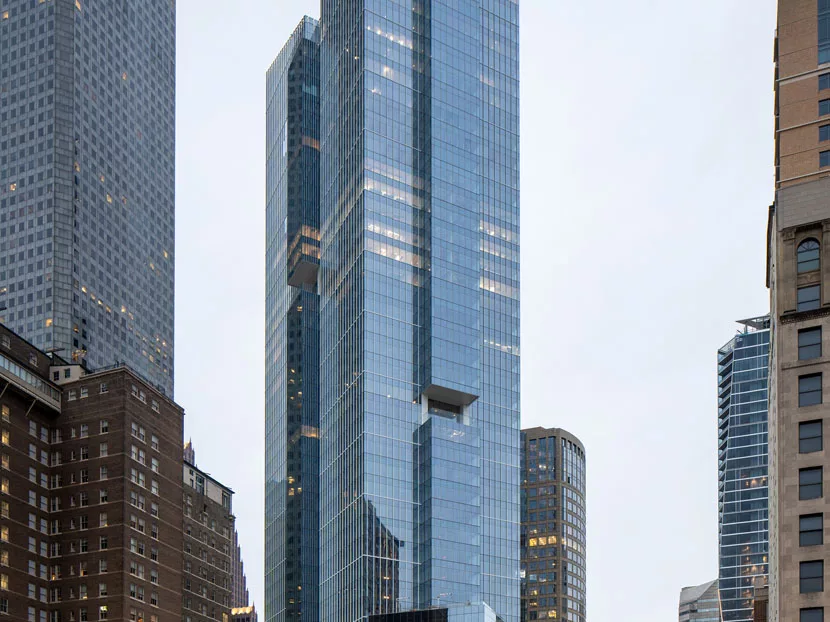Urban downtowns continue to evolve rapidly, and not all the change is stoked by COVID-19 and its effects on commercial real estate and office work. One big transformation revolves around office buildings themselves. The old approach — high-rise monoliths with simple roofs, multiple floors, a building lobby and below-grade parking — is increasingly taking a bow in downtowns from Boston to Kansas City to San Diego.
Instead, new buildings incorporate nonlinear massing, terraces, amenity decks, green roofs and sustainable goals to allow for a more employee- and environment-friendly built workplace.
The new style offers myriad advantages, but it also poses fresh engineering challenges, including plumbing. And when the high-rise happens to be in hurricane-prone downtown Houston, the plumbing challenges grow even more formidable. Among other things, the city imposes a range of novel and strict building regulations related to plumbing. Working within the regulatory structure demands quite a bit of engineering and design savvy.
The results, though, can set new standards for plumbing engineering in flood-prone areas. A new 48-story, 1-million-square-foot, Class A office building called Texas Tower (nicknamed T2) — the sixth tallest building in Houston that recently opened with glowing reviews — serves as a shining example of forward-thinking high-rise engineering and construction.
Developed by Hines, designed by Pelli Clarke Pelli Architects (design architect) and Kendall/Heaton Associates (architect of record), and with MEP engineering handled by ME Engineers, the new building tenants include Hines itself, one of the largest privately held real estate investment, development and management firms in the world.
Among Hines’ 31 prominent projects in Houston’s downtown district, Texas Tower, which cuts a distinct presence in the city’s skyline, fulfilled the highest standards of any Hines-built project in Houston, including LEED Platinum (the largest in the United States), WiredScore and WELL building standards.
The building’s vertically integrated campus includes public gardens on the 12th floor (which required profound plumbing challenges); 10-foot, full-height windows; a sophisticated underfloor HVAC system; and a variety of atriums and communal spaces.
The Vault
Among the many plumbing challenges surrounding Texas Tower, the building’s stormwater drainage system proved to be the project’s most profound. A variety of factors impacted the stormwater drainage system’s design. For example, Levels 12 and 13 incorporate roughly 53,000 square feet of outdoor amenity space, with raised pavers, planters and 575 vertical feet of exterior building surface above them (see Figure 1).

The amenity decks used conventional roof and overflow drains below the raised pavers and planter drains in landscaped areas. Rainwater shedding off the adjacent vertical surface gets collected into a continuous trench drain installed at the base of the vertical wall, with conventional roof and overflow drains strategically located within the trench (see Figure 2).

City code requires accounting for 50% of the adjacent vertical surface in stormwater drainage calculations, leading to 59,500 square feet for stormwater drainage calculations, plus another 12,400 square feet of the horizontal deck: 71,900 square feet in all. Applying the city-mandated 8-inch/hour rainfall intensity rate resulted in a calculated flow of 5,975 gallons per minute.
To accomplish this, the team routed a 24-inch galvanized steel pipe with grooved couplings from the Level 11 ceiling to a storm detention vault located on the B1 level of the garage. Stormwater discharged from this vault to the city storm sewer system was restricted to historic release rates calculated for the original site conditions.
The engineering and construction work surrounding the guiding of stormwater into the storm detention vault occurs twice on the Level 12 amenity deck, on both the north and south sides of the deck. In addition, a similar condition exists on the Level 13 amenity deck, although to a lesser degree (38,750 square feet, with 3,220 gallons/minute calculated flow through the drainage system).
Engineers sized the branch piping serving each of these areas for their respective loads, but when all branches are collected, only one side of the load gets carried through to the storm vault as wind-driven rain typically affects just one side of the building, rather than multiple sides simultaneously.
Managing stormwater drainage requirements also posed challenges at the lobby-level pavilion roof, which extends beyond the superstructure footprint. Four 10-inch roof drains remove water from the roof; the water then gets sent to a 15-inch vertical storm pipe (see Figure 3). Given the location of the pavilion with respect to the storm vault, gravity drainage was not possible. Instead, a triplex sump pump directs storm flow to the storm vault.
The storm vault itself ties into another interesting Texas Tower feature: a rainwater reclamation system designed to treat available stormwater for site irrigation purposes. The equipment includes particulate filters, chemical treatment, UV treatment and a 1,200-gallon reservoir designed to maintain the irrigation water. This system also includes potable water backup and a high-head pump to provide irrigation for landscaped areas surrounding the building, as well as the gardens and planters on the amenity decks on Levels 12 and 13.
The complexities and formidable engineering and construction hurdles related to stormwater drainage required close coordination with all trades to avoid conflicts.
Pipe ‘Bath’
Houston’s plumbing code impacted other areas of the design and construction. For example, the city prohibits plumbing from being encased within any concrete element. However, the building’s core areas rest on 8- to 12-foot-thick concrete mat-slab construction; due to stresses beneath the slabs, the engineering team concluded that pipe trenching beneath them was ill-advised.
After negotiation with the Houston Plumbing Inspection Division, the city allowed piping within the concrete, provided Schedule 40 PVC pipe and fittings were used.
This posed a unique dilemma: the cure temperature of the concrete pours would rise above 140 F, which would erode the structural integrity of the PVC pipe. To ensure that the PVC piping maintained its integrity during the concrete pour and curing time, the team built a cold water bath that circulated within the piping to maintain water and pipe temperature below the temperature rating of the pipe (see Figure 4).

This was no small feat. Creating the mat-slab foundation required a monolithic pour during a continuous 20-hour operation involving 14,000 cubic yards of concrete and 1,800 tons of No. 18 rebar. During the entire process, the cold water bath maintained appropriate temperatures for the PVC piping while not interfering with the temperature demands of the surrounding, and setting, concrete.
Other plumbing aspects of Texas Tower were more typical for high-rise design. For example, the sanitary, drain and vent system was a conventionally vented system with cast-iron pipe and heavy-duty, no-hub couplings. Construction provided sanitary and vent-capped connections at each end of the building for future tenant use.
Separate sanitary stacks serve cooling tower drain-down; sand filter backwash operations were provided. These stacks were routed down through the building and connected to the Level 11 mechanical ceiling, where all sanitary stacks were collected. The design prevents any pressure fluctuations, which can result in unsatisfactory operation at the base of these stacks.
For the domestic water system, the team used an open break tank with a triplex booster pump system at the ground level to feed the building. Pressure-reducing valve stations were provided for every six office floors to ensure adequate pressure throughout the floors. Each floor incorporated a valved and capped cold water connection for future tenant improvements.
While storm drainage and recycling systems stand out for their engineering innovations, the award-winning Texas Tower project includes other noteworthy plumbing feats.
A network of underground tunnels spread out beneath Houston’s Downtown District, and the team designed Texas Tower to include a portion of this 6-mile-long system. To further bolster fire protection, the team extended the fire protection system from Texas Tower into the tunnel, along with mechanical and electrical systems that fanned out from the building into the tunnels.
Also, to support future food service tenants, the design and construction teams installed grease interceptors on level B1 of the garage. Access to the grease interceptors required manhole placement in landscaped areas at Level 1, which dictated the locations of interceptors on Level B1.
More Weather Stresses on Buildings
Designing and building world-class downtown high-rises today demands far more ingenuity, savvy and finesse than only a decade ago. Welcome requirements for sustainable and environmentally friendly buildings introduce a wide range of considerations, techniques and materials that were infrequently, or never, considered in the relatively recent past.
Climate professionals predict increasingly more stormwater and floodwater stresses on buildings, especially buildings close to coasts with rising sea levels or that are routinely in the path of storms such as hurricanes. Building design and construction must meet these challenges with creative solutions to preserve building integrity while simultaneously achieving sustainability goals and providing comfort and convenience for office workers.
Few North American cities today present as many challenges for tall office building construction as low-lying Houston, the downtown of which floods several times a year when storms — and not only hurricanes — roll through. In addition to the engineering demands that such flooding presents, the city also imposes uniquely rigorous codes and regulations that influence building design and construction, and often require ingenious solutions.
Catching, redirecting and moving water revolves around plumbing engineering, which is growing more and more robust and forward-thinking as buildings must contend with historic water stresses. Texas Tower, which opened in December 2021, represents a standard-setting high-rise office building located in a flood-prone downtown of a city with especially comprehensive and intense stormwater regulations.
Even though Texas Tower is not even two years old, it already serves as a model building for the city of Houston.
Stephen Shayler is an associate at ME Engineers. He has more than 40 years of experience in engineering and designing medical gas, process piping, plumbing and fire protection systems for high-rise office towers, multifamily mixed-use developments, commercial buildings and higher educational facilities. Shayler is certified in plumbing design and green plumbing design by the American Society of Plumbing Engineers.





